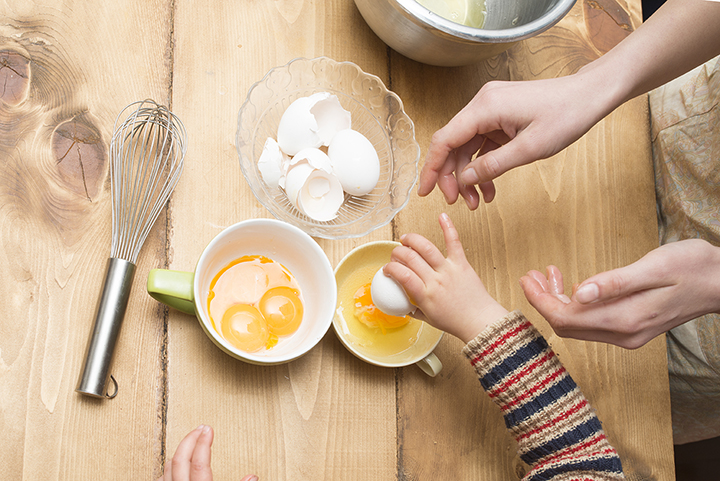Children love what we love. They respond positively when we are positive, and negatively when we are negative. They flourish when they feel trusted, appreciated, and welcomed. I am working hard as a parent to foster a love of food in my child and with my nieces and nephews, which I hope will lead to a love of food preparation and kitchens, where so much of life takes place! Here are a few simple methods I use to foster and encourage a love of kitchens, and all the cooking, baking, and cleaning that happens there.
1. Exploration: Flour and Cookie Cutters
For little ones who are not yet old enough or ready to help prepare food, allow them to explore ingredients. I like to set out a baking sheet with a heap of flour on it, and a handful of cookie cutters. Children are wildly creative, and it’s remarkable what they’ll think up with nothing more than flour and cookie cutters. If you are concerned about the potential mess, consider using a dedicated apron and choose a space that is easy to sweep up. Dried beans are another good ingredient for exploring.
2. Anticipation: Let Them Choose the Recipe
Rather than including little ones in the baking of a pie that you’re supposed to have ready in two hours for a family reunion, invite children to help on a day when there are no high stakes. This removes any pressure, and allows you to enjoy the slowness, intention, and messiness of a child at work. Whenever I can, I like to open one of my favorite cookbooks and sit it on the floor, nearby my nieces and nephews. I say things like, “What should we bake today?” or, “Wouldn’t it be fun to make this cake?” In no time, their little hands end up turning the pages and saying, “Oh, this one!” I’ve noticed that when I say “yes” to a recipe that’s intriguing to them (even if it’s not exactly what I was craving), children are more engaged and excited in the preparation.
3. Connection Over Correction: Let Them Try
The first five (ten? twenty?) times a child cracks an egg into a mixing bowl, they are bound to get shell in there, too. That’s OK. Just as adults appreciate encouragement as we learn new things, so too do children! Rather than saying, “You cracked it too hard and now there’s eggshell in the bowl,” perhaps try, “Good job! You were very focused.”
4. Inclusion: Show and Tell
While I know my baby can’t help make coffee yet, I can let her smell the bag of coffee beans and feel the warm mug. I’m learning quickly (first time mom here!) that babies want to touch everything. Why should we stop them? If there are objects you would be devastated to have break, like a beloved coffee mug, then keep it out of reach, and instead offer one that is either A) less sentimental, or B) unbreakable. Or offer a wooden spoon, which surely won’t break. It brings such joy to watch a baby touch and explore things in and around the kitchen. When I’m washing the dishes with my baby on my hip, I talk through what she’s seeing. “This is water coming from the faucet,” and, “Mama is washing the cake pan.” While I can’t say for sure, I hope the early exposure and inclusion in all things related to the kitchen will help to foster a sense of comfort and familiarity as she grows.
How do you encourage little ones in the kitchen? Any tips involving small hands in big work?


































Great ideas! All of them sounded optional for almost any age or learning level. If you have several children in the kitchen, simple meals with no-fuss skills are all that’s needed to make a child feel involved. Keep cooking!!
Funny how we have come full circle. This is how parents, especially stay at home moms, used to do things. Now it is embraced from the Montessori way of child development. If kids don’t see and do, they never learn. If you are always saying this is my work or you are doing it wrong, like everyone, they walk away.